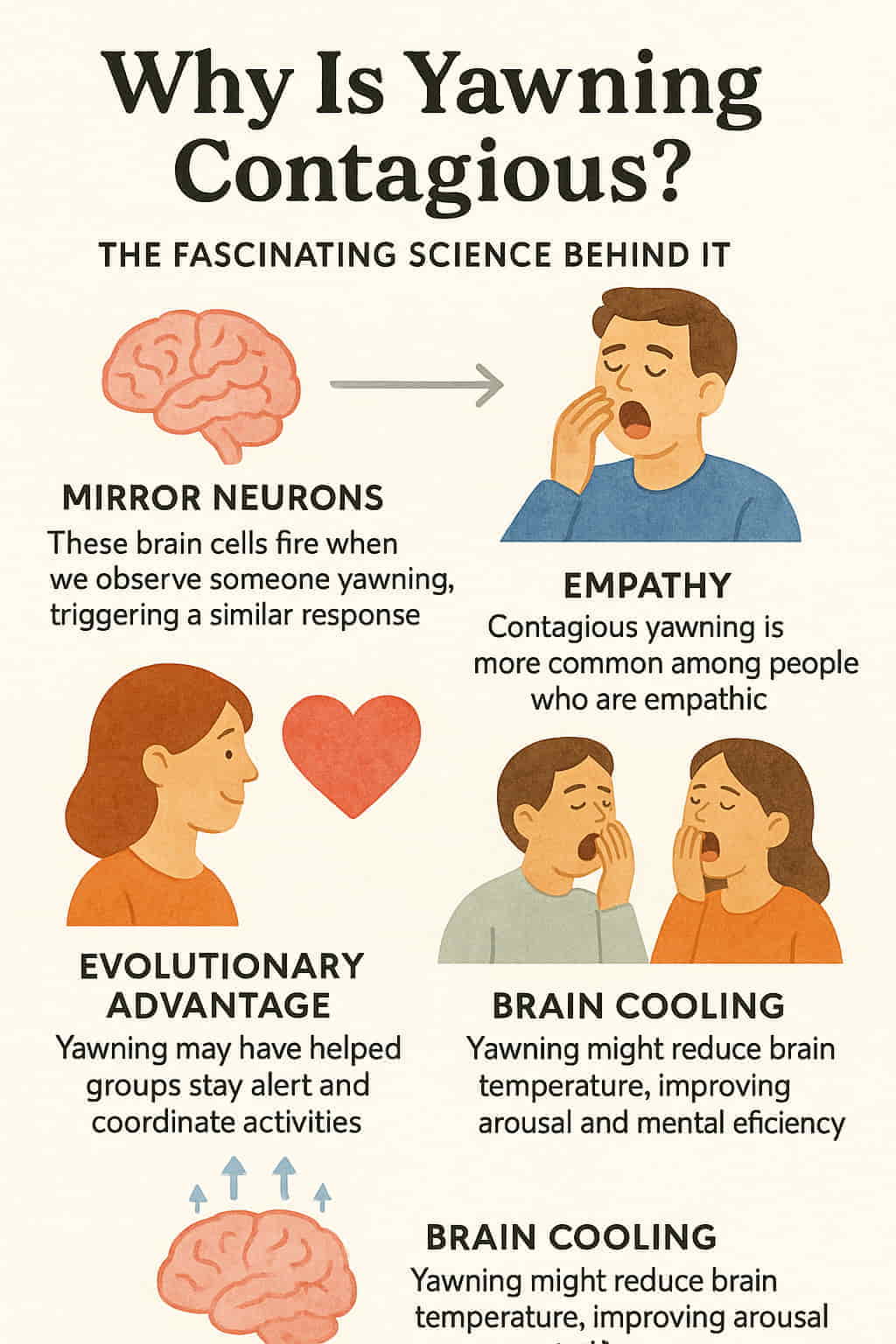
There’s a strange, almost magical social reflex we all know too well: someone yawns, and you feel the irresistible urge to yawn too. But why is yawning contagious? It’s a question that has puzzled scientists, psychologists, and philosophers for centuries. Far from being a trivial quirk of human behavior, contagious yawning offers a window into the mechanics of empathy, brain function, and even evolution.
In this article, we’ll explore the science behind yawning, why it’s contagious, and what your involuntary yawns might reveal about your brain. We’ll also delve into the evolutionary roots of this behavior and the intriguing studies that shed light on the topic.
What Is a Yawn, Really?
A yawn is a stereotyped reflex consisting of an open mouth, a deep inhalation of air, and a slow exhalation. But it’s more than just a signal of boredom or sleepiness. Yawning serves physiological functions, including cooling the brain, increasing oxygen intake, and stretching facial and neck muscles.
Interestingly, not all yawns are created equal. Spontaneous yawns happen when you’re tired or bored. But contagious yawning is a social phenomenon triggered by seeing, hearing, or even thinking about someone else yawning. And yes — just reading this probably made you yawn.
Contagious Yawning: A Uniquely Social Reflex
So, why is yawning contagious?
Research suggests it has to do with mirror neurons—special brain cells that fire both when you perform an action and when you observe someone else doing it. These neurons are thought to play a central role in empathy and imitation. When you see someone yawn, your mirror neurons may activate the same neural pathway, causing you to yawn too.
But there’s more. A landmark study from Baylor University found that people with higher empathy scores were more likely to catch a yawn from others. Children with autism, for instance, often do not exhibit contagious yawning, highlighting a potential link between this reflex and social cognition.
H2: Why Is Yawning Contagious Among Humans and Some Animals?
Humans aren’t the only species prone to contagious yawning. Chimpanzees, bonobos, and even dogs have been shown to “catch” yawns — especially when they’re observing members of their own social group.
In a well-known 2008 study published in Biology Letters, dogs were found to yawn after watching humans yawn, particularly if they had a strong bond with the person. This suggests that contagious yawning may be rooted in empathy and social connection, traits that extend beyond humans.
So when asking why is yawning contagious, it may be more accurate to ask: why do socially intelligent species yawn together?
Evolutionary Theories: Herding, Synchronization, and Brain Cooling
Yawning isn’t just about sleep. Evolutionary biologists have proposed several theories about why yawning — particularly contagious yawning — might offer a survival advantage.
1. Group Vigilance Theory
Yawning may have evolved to synchronize group behavior, such as sleep cycles or alertness. If one member of a group became tired or needed rest, a yawn could signal others to prepare for the same. This would be especially useful in early human or primate groups vulnerable to predators.
2. Brain Cooling Theory
A 2014 study in Physiology & Behavior suggested that yawning helps cool down the brain, improving mental efficiency. In social groups, one yawn may prompt others to optimize brain function together — a kind of collective refresh.
3. Communication of Empathy
Contagious yawning may signal an ability to understand and share the emotions of others. By mirroring another’s yawn, you unconsciously express your social attunement, helping to strengthen group bonds.
Outliers and Exceptions: Who Doesn’t Yawn?
You’d expect everyone to catch a yawn, right? Not so fast. While most adults experience contagious yawning, several groups show reduced or no response:
-
Children under age 5 rarely catch yawns. Their brains may not have developed enough empathic capacity yet.
-
Individuals on the autism spectrum show significantly less susceptibility to contagious yawning, especially when they have lower levels of social engagement.
-
People with schizophrenia also tend to yawn less contagiously, possibly due to disruptions in mirror neuron systems or altered social cognition.
These exceptions further support the theory that contagious yawning is linked to empathy and the brain’s social-processing centers.
Is It Possible to Resist a Yawn?
If you’ve ever tried to suppress a yawn after seeing someone else do it, you know it’s hard — but not impossible. Functional MRI studies have shown that people who consciously try to resist yawning experience increased activity in the prefrontal cortex, the part of the brain responsible for decision-making and inhibition.
However, even with effort, most people still yawn eventually. The action is deeply ingrained and semi-automatic, meaning that even if you can delay it, the urge to yawn tends to win out.
Neuroscience Behind Contagious Yawning
Brain imaging has pinpointed specific regions involved in contagious yawning. Notably:
-
Posterior cingulate cortex
-
Precuneus
-
Inferior frontal gyrus (home of mirror neurons)
In 2013, a study from the University of Nottingham published in Current Biology concluded that the susceptibility to contagious yawning is linked to cortical excitability, particularly in the primary motor cortex. The more excitable your motor cortex, the more likely you are to mimic others’ yawns involuntarily.
Can Contagious Yawning Be Used Clinically?
While not a diagnostic tool on its own, contagious yawning has potential as a neurological and psychiatric marker. For example, researchers are studying yawning responses as part of assessments for:
-
Autism spectrum disorders
-
Schizophrenia
-
Brain injuries
-
Multiple sclerosis
By measuring how someone reacts to visual yawn cues, clinicians might gain insight into social and neurological function in a non-invasive way.
Debunking Myths About Yawning
Let’s clear up a few misconceptions:
-
Yawning doesn’t always mean you’re tired. It can happen when you’re anxious, bored, or even during exercise.
-
Yawning doesn’t increase oxygen intake significantly. That was a widely believed theory, but recent studies have cast doubt on it.
-
Yawning in animals isn’t always emotional. Sometimes it’s just thermoregulation — especially in reptiles and birds.
While contagious yawning is fascinating, not every yawn carries a social message.
Outbound Resources
For more on the neuroscience of social behavior, check out the National Institute of Neurological Disorders and Stroke and Harvard’s Brain Science Initiative. Both offer in-depth research on mirror neurons, empathy, and brain function.
If you’re curious about animal cognition, explore the Smithsonian’s National Zoo resources on primate behavior and empathy in species like bonobos and elephants.
FAQ: Why Is Yawning Contagious?
Q: Is contagious yawning a sign of empathy?
A: Yes. Studies show a strong link between contagious yawning and empathic ability. The more empathetic a person is, the more likely they are to catch a yawn.
Q: Do animals yawn contagiously too?
A: Yes. Dogs, chimpanzees, and some other social animals show contagious yawning, especially within strong social bonds.
Q: Can someone be immune to contagious yawning?
A: Some people — especially young children or individuals with autism — are less likely to yawn contagiously, often due to differences in social cognition.
Q: Does yawning serve a purpose besides signaling sleepiness?
A: Absolutely. Yawning may help cool the brain, increase alertness, or synchronize group behavior.
Q: Can contagious yawning be controlled?
A: You can resist it temporarily, but it’s difficult due to its deep neurological roots in mirror neurons and motor control.





